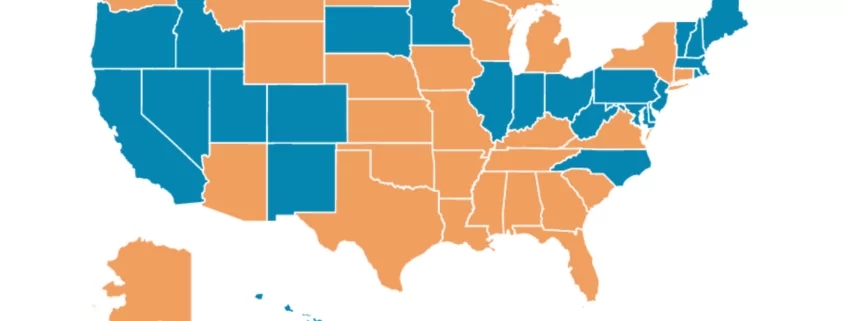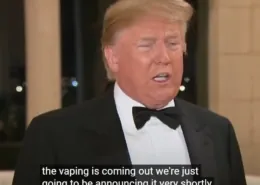The Best and Worst States To Vape in the US
The world of tobacco alternatives is undergoing a significant transformation, with vaping playing a leading role. As this trend continues to gain traction, the regulatory climate in the United States is responding accordingly. The complexities of this rapidly evolving landscape have triggered a myriad of responses, resulting in a diverse spectrum of state-level policies. Recently, the Consumer Choice Center (CCC), a leading U.S. consumer advocacy group renowned for championing consumer rights, has emerged as a beacon of guidance, providing clarity amidst the intricate web of vaping laws across the nation.
The CCC has created the U.S. Vaping Index, an extensively detailed and well-researched report engineered to examine the unique regulatory framework within each state concerning vaping. The primary objective of this tool is to empower vapers with the requisite knowledge to successfully navigate these regulatory mazes and, if needed, spearhead movements against unnecessarily restrictive vaping laws. The report ingeniously classifies each state into one of three grades, each corresponding to the relative ease or difficulty of vaping in the region.
Let’s venture deeper into the intricacies of this groundbreaking index, shedding light on states where vaping is the least and most encumbered by regulatory measures.
The U.S. Vaping Index
In formulating the U.S. Vaping Index, the CCC took a rigorous approach, meticulously examining both state and federal-level regulations. The primary objective of this endeavor was to assess the unique ways in which each state had chosen to interpret and enforce federal mandates, specifically regarding the decision to either increase or decrease restrictions on vaping. To streamline this assessment, the index utilized three critical factors as benchmarks for assigning rankings:
- The presence or absence of flavor bans.
- The level of taxation imposed on vaping products.
- The degree of regulation concerning online sales.
The evaluation of each state’s performance across these categories determined their score on the index. States that amassed a score of 21-30 points were lauded with an “A” grade, signifying a vaping-friendly environment. In stark contrast, states languishing with a score of only 0-10 points were relegated to an “F” grade, indicative of an inhospitable climate for vapers. A state accumulating a score of 11-20 points merited a “C” grade, indicating a relatively balanced regulatory landscape.
The Index’s comprehensive scope covered all 50 states and the District of Columbia, purposefully disregarding any legislation still pending. The focus remained solely on laws that were either implemented or explicitly rejected at the state level, underscoring the concrete impact of existing regulations on vaping practices.
Federal vs. State Regulations
Federal regulations do impose some restrictions on the taxation of certain goods, but states have the flexibility to add further taxes on the sale of vaping products, e-liquids, and other flavored vape items. The Index undertook the task of evaluating which states opted to exercise this power and examined the resultant impact on each state’s final score.
The federal government’s flavor ban, on the other hand, does not levy direct penalties on states that choose to partake. Nonetheless, states that opted to extend the ban or make it permanent faced a dip in their index score, reflecting the additional restrictions imposed on vapers in these regions.
When it comes to the online sale of vaping products, there is currently no federal regulation in place, granting each state the autonomy to establish its own rules and guidelines. The Index carefully considered whether states had total bans, some restrictions, or no limitations on online sales of vaping products, significantly influencing their final ranking.
The Best and Worst States for Vaping
After an exhaustive evaluation, the U.S. Vaping Index divided the 51 regions into three ranking categories:
- 25 states, including Washington D.C., achieved an “A” grade.
- 20 states were given a “C” grade.
- A mere 6 states ended up with an “F” grade.
The states with an “A” grade spanned across the geographic and political landscape of the country, ranging from the northern wilderness of Alaska to the sunny climes of Florida. These states demonstrated an overall tolerance towards vaping, evidenced by the lack of strict flavor bans, modest levels of taxation, and relatively relaxed restrictions on online sales.
On the other hand, “C” grade states, from Washington to Maine, exhibited a more diverse approach to vaping regulation. These states had chosen to impose additional e-cigarette taxes in recent times but had not necessarily instituted rigorous flavor bans or stiff online sale restrictions.
Lastly, states with an “F” grade, home to significant populations and wealth, had enacted strict restrictions across all three areas of assessment. For vapers residing in these states, such as California, New York, and Massachusetts, the practice of vaping represented a financial and logistical challenge.
Charting the Path to a More Balanced Regulatory Landscape
The U.S. Vaping Index is more than just a simple rating system; it’s an advocacy tool that illuminates the pressing need for a more balanced approach to vaping regulation. It urges lawmakers to consider the potential benefits of vaping as a viable and safer alternative to traditional smoking while simultaneously addressing public health concerns.
While the ultimate goal should not be complete deregulation, a middle ground must be struck between total prohibition and uninhibited access. The Index supports the idea that consumers should have the freedom to choose healthier alternatives, advocating for the lifting of unjustified restrictions and high taxation.
Moreover, the Index could potentially spark informed dialogue and fuel legislative changes. As lawmakers and public health officials become aware of the discrepancies highlighted by the Index, there may be a push towards more equitable vaping regulations, improving the climate for vapers across the nation.
Read more:
Deeper Insights Through Frequently Asked Questions
What is the U.S. Vaping Index, and why is it important?
The U.S. Vaping Index is a detailed report that highlights each state’s vaping regulations. By spotlighting the variance in state laws, it serves as an essential resource for vapers, public health advocates, and policymakers, informing future regulatory discussions and potential reforms.
How does the U.S. Vaping Index classify states?
The Index ranks states based on their implementation of flavor bans, taxation on vaping products, and regulation of online sales. The combined score determines whether a state falls into the “A” (vape-friendly), “C” (balanced regulations), or “F” (restrictive laws) category.
What is the significance of federal vs. state regulations in the context of vaping?
Although federal regulations set a baseline, states have the discretion to enforce additional laws and taxes on vaping. This variance can drastically alter the vaping experience and accessibility in different regions, thereby influencing a state’s grading in the Index.
Can the U.S. Vaping Index shape the future of vaping laws?
By pinpointing the disparities in state vaping laws and the impact of restrictive regulations, the U.S. Vaping Index could drive changes in the regulatory landscape. Its findings could motivate advocacy groups, policymakers, and even the general public to push for more balanced vaping regulations that consider both public health concerns and individual freedoms.
- Minneapolis Sets $25 Minimum Price for E-Cigarettes - July 11, 2025
- Alabama Schools to Implement New Anti-Vaping Policies - July 11, 2025
- Is Vaping and Driving Illegal in Rhode Island? (2025 Guide) - July 10, 2025









